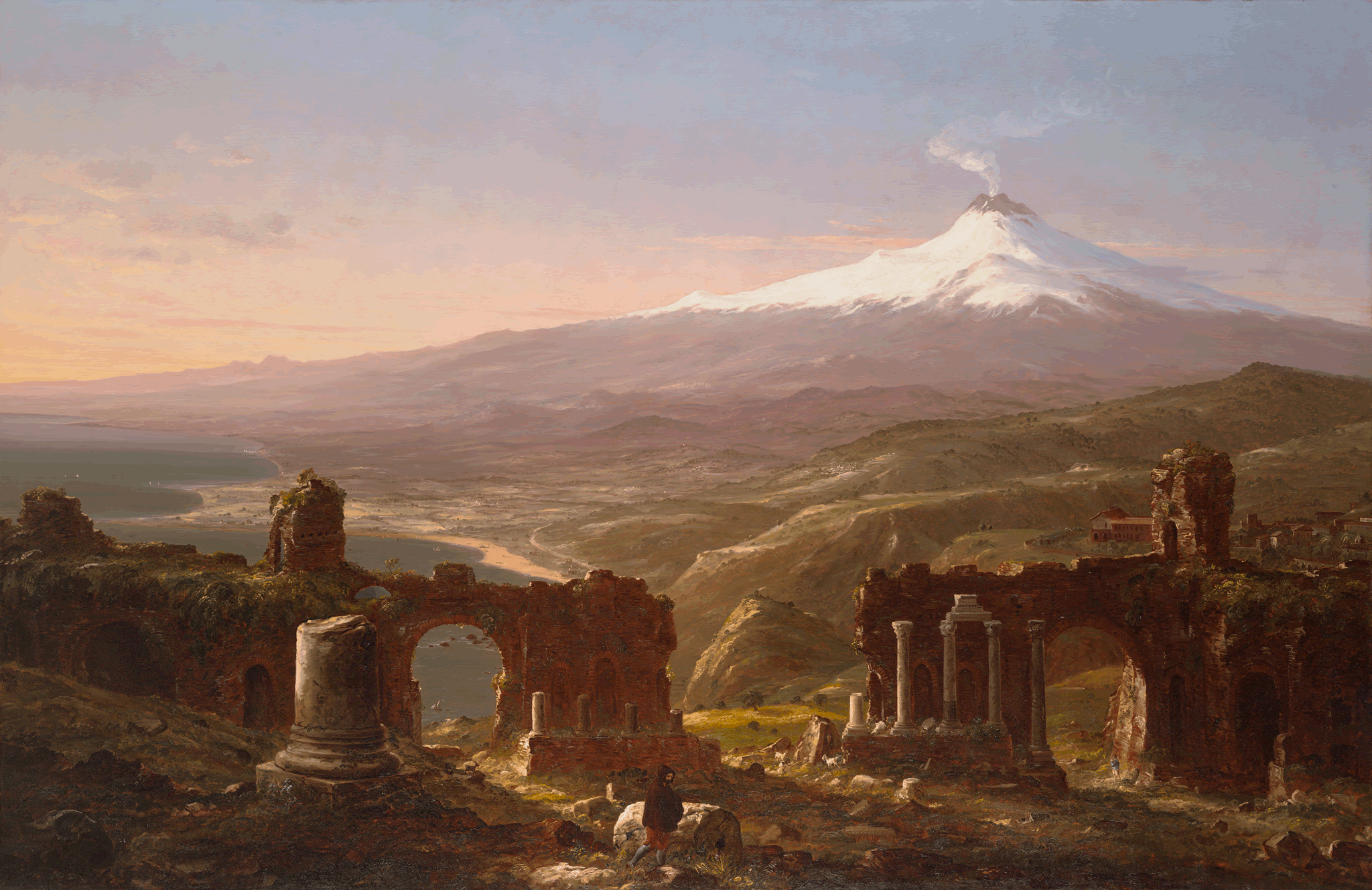Mount Etna From Taormina, Sicily

Thomas Cole. Oil on canvas, 1843, 48 x 32 ½ in. Wadsworth Atheneum Museum of Art, Hartford, CT. Purchased from the artist by Alfred Smith, Daniel Wadsworth, and the original subscribers to the Wadsworth Atheneum, 1844.6.
About
Decode
Compare
Cole's Process
Cole's Words
Locate
About
Before Cole's first trip abroad in 1829-32, his friend William Cullen Bryantpenned a gentle warning to him in the form of a poem:
Thine eyes shall see the light of distant skies:
Yet, Cole! thy heart shall bear to Europe's strand
A living image of our own bright land,
Such as upon thy glorious canvas lies;
Lone lakes—savannas where the bison roves—
Rocks rich with summer garlands- solemn streams—
Skies, where the desert eagle wheels and screams—
Spring bloom and autumn blaze of boundless groves.
Fair scenes shall greet thee where thou goest—fair,
But different—everywhere the trace of men,
Paths, homes, graves, ruins, from the lowest glen
To where life shrinks from the fierce Alpine air.
Gaze on them, till the tears shall dim thy sight,
But keep that earlier, wilder image bright. 1
Despite Bryant's admonitions, and the nationalistic sentiments that Cole himself expressed in own writings on American scenery, the artist fell in love with the Italian landscape—a love reflected in his many depictions of famous Italian sites. He returned to Italy for a second time in 1841-42, where he visited Sicily for six weeks. There he saw Mount Etna, a massive snow-covered volcano that looms over the area. Traveling with another artist, Cole climbed the volcano by night and arrived at its summit just in time to see the sunrise. Writing of the event in The Knickerbocker magazine in 1844, Cole exclaimed:
It was a glorious sight which spread before our eyes! We took a hasty glance into the gloomy crater of the volcano, and throwing ourselves on the warm ashes, gazed in wonder and astonishment. It would be vain for me to attempt a description of the scene. I scarcely knew the world in which I had lived. The hills and valleys over which we had been traveling for many days, were comprised within the compass of a momentary glance. 2
After the descent from Mount Etna, the pair traveled to Taormina, where Cole made several sketches of the ruins of a Greek amphitheater with the volcano in the background.
Returning to New York, Cole worked on Mount Etna from Taormina in the new rooms of the National Academy of Design, based on the sketches he had drawn at the site. Astonishingly, he completed this monumental canvas (nearly 10 feet in length) in only five days and exhibited it at his one-man show at the National Academy in December 1843. It is only one of many depictions of Mount Etna that Cole executed after his second Italian sojourn. The painting was acquired by the newly established Wadsworth Atheneum in Hartford, founded by the artist's long-time patron, Daniel Wadsworth. 3
Decode
Mouse over the detail to view its caption, click it to zoom in, and use the reset button on the lower right to zoom back out.
1. Known as Mongibello in Italian, Mount Etna is nearly 11,000 feet high and is the largest active volcano in Europe.
2. The view of the eastern coast of Sicily across the Bay of Naxos looks from north to south, where the region meets the Mediterranean Sea.
3. The ruins of the Greek amphitheater in Taormina was built in the Hellenistic period (third century B.C.E.). The structure evokes romantic sentiments regarding past civilizations.
4. The town of Taormina appears in the distance.
5. A broken column, reminiscent of the one Cole painted in The Course of Empire: Desolation six years earlier, recalls the romantic theme of the rise and fall of ancient civilizations.
6. This hooded figure, a rural Sicilian of Cole's time, traverses the ancient site.
7. Goats frolic among the ruins, symbolic of the pastoral landscape.
Educated travelers like Cole planned their European itineraries by consulting books such as (1823). Such lavishly illustrated publications whetted the appetite of American artists who wanted first-hand experience of the famous stops on the Grand Tour. Cole probably closely studied this published view of the renowned Hellenistic ruins at Taormina, since his painting, , is very similar to the vantage point of DeWint’s image.
Compare
Peter DeWint, View of Aetna from the Theatre at Taormina, Engraving by Robert Wallis after Peter DeWint, 1822. Published in Peter DeWint, Sicilian Scenery from Drawings by Peter DeWint: The Original Sketches by Major Light (London, 1823).
Process
These two pencil sketches and the accompanying oil study are three examples of Cole's en plein airsketching process during his second trip to Italy (1841-42). In Mt. Etna from Taormina, Cole created a very detailed study of the ruins of the amphitheater, with light pencil marks in the background delineating the summit of the mountain. At the top of the sheet, he recorded his emotional response to the view: "What a magnificent site! Aetna with its eternal snows towering in the heavens—the ranges of nearer mountains—the deep romantic valley—the bay of Naxos...I have never seen anything like it. The views from Taormina certainly excel anything I have ever seen."
The second pencil sketch, Taormina, is a view of the amphitheater looking westward, in a vertical format (rare for Cole). The ruins here are even more detailed, and Cole has added a figure with a hat, perhaps a picturesque Italian resident or a surrogate for the artist. Instead of Mount Etna in the background, we see Monte Tauro; this indicates that Cole worked from several different viewpoints.
With the outlines of the forms recorded in his sketchbook, Cole moved on to the oil sketch, in which he used thick, wet brushstrokes to mark down the colors and effects of light on the scene. 1 Interestingly, a fog hides the top of Mount Etna at midday. 2
Executing oil sketches en plein airwas an arduous endeavor in Cole's time. According to his contemporary William Dunlap, Cole mixed his paints in the field, which would have necessitated carrying a heavy mullerand grinding stone. 3 The artist's correspondence indicates that Cole also purchased premixed paints stored in pig's bladders for his en plein air work, 4 but these could easily burst and spoil the already-completed sketches he was carrying. In order to work in the open air, he also needed to carry a paint box, palettes, brushes, sketchbooks, boards or wooden panels to paint on, an umbrella, and a folding chair.
Back in his makeshift studio at the National Academy, Cole combined the information from the pencil and oil sketches to create the finished painting. This work, executed quickly in thin, gestural strokes resulting in scumbled paint surfaces, allows the warm, red ground to show through. Cole's journals indicate that he pondered complicated color theories found in manuals such as George Field's Chromatics (1817) and that he favored warm grounds throughout his career for carefully considered coloristic effects. 5 Given the luminous, mellow qualities of Italian light, the choice of red ground color is particularly appropriate for the subject. Significantly, the painterly qualities of this late work contrast with the more controlled surfaces of his earlier paintings.
Works
1. Thomas Cole, Mt. Etna from Taormina, pencil on toned paper, 1842, 11 5/8 x 32 ½ in. Detroit Institute of Arts. Founder Soiety Purchase, William H. Murphy Fund, 39.400. View in Virtual Gallery
2. Thomas Cole, Taormina, Pencil on toned paper, 1842, 14 ¾ x 10 7/16 in. Detroit Institute of Arts, Founders Society Purchase, William H. Murphy Fund, 39.398. View in Virtual Gallery
3. Thomas Cole, The Ruins at Taormina, oil and pencil on board, 1842, 12 x 16 1/8 in. Berry-Hill Galleries, Inc., NY. View in Virtual Gallery
4. Thomas Cole, Mount Etna From Taormina, Sicily, oil on canvas, 1843, 48 x 32 ½ in. Wadsworth Atheneum Museum of Art, Hartford, CT. Purchased from the artist by Alfred Smith, Daniel Wadsworth, and the original subscribers to the Wadsworth Atheneum, 1844.6.
Words
Let not the ostentatious gaud of art,
That tempts the eye, but touches not the heart,
Lure me from nature's purer love divine;
But, like a pilgrim, at some holy shrine,
Bow down to her devotedly, and learn,
In her most sacred features, to discern
That truth is beauty. 1
But for yon filmy smoke, that from thy crest
Continual issues; there would be no sign
That from thy mighty breast bursts forth at times
The sulphurous storm—the avalanche of fire;
That midnight is made luminous and day
A ghastly twilight by thy lurid breath.
By thee tormented Earth is tossed and riven;
The shuddering mountains reel; temples and towers
The works of man and man himself, his hopes
His harvests, all, a desolation made!
Sublime art thou O Mount! Whether beneath
The moon in silence sleeping thy woods
And driven snows, and golden fields of corn;
Or bleat upon thy slant breast the gentle flocks,
And shepherds in the mellow flow of eve
Pipe merrily; or when thy scathed sides
Are laved with fire; answered thine earthquake voice
By screams and clamor of affrighted men.
Lone mountain of the pallid brow and heart
Of fire! Thou art a resting place for thought,
Thought reaching far above thy bounds; from thee
To Him who bade the central fires construct
This wond'rous fabric; lifted by thy dread brow
To meet the sun while yet the earth is dark,
And ocean with its ever murmuring waves. 2
Find it here.
